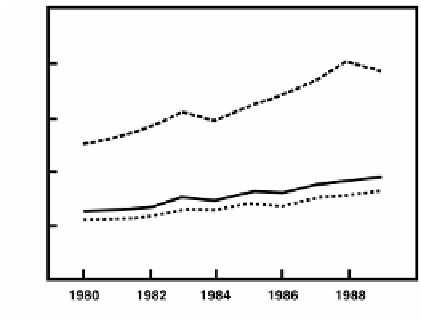Environmental Engineering Reference
In-Depth Information
Whether an individual becomes sensitized depends on the nature of the
antigen, the amount of antigen, route and frequency of the exposure, and
one's genetic background. Some individuals have a high propensity for
becoming sensitized to (often many) antigens. This genetically determined
predisposition to allergy is called atopy. Most individuals with severe allergic
symptoms are atopic.
B.
Asthma
Asthma is a disease that affects the respiratory airways of the lung. It is
characterized by severe episodic constriction of bronchial tubes, which
results in chest tightness, shortness of breath, coughing, and wheezing.
Symptoms, which vary in severity, may occur within hours of exposure to
allergens or nonspecific irritating substances (or activities) or have a delayed
onset (4 to 12 hours later).
The prevalence of asthma in the U.S. has been estimated to be about
4.3%, or about 10 to 12 million individuals a year experiencing mild to severe
asthmatic symptoms. The prevalence rate has increased 50% since 1980, with
the annual death rate doubling to approximately 5000 per year (
Figure 5.1
)
.
The increase in the prevalence of asthma has been disproportionately higher
in females, particularly for black females (prevalence rate 6%). The preva-
lence rate for white females is about 4.7%.
Asthma prevalence in children varies both regionally and across racial
groups. Data obtained from the National Health and Nutritional Examina-
tion Survey II (NHANES) conducted for the period 1976-1980 showed that
the cumulative percentage of asthma symptoms (sometime in their lives)
was approximately 8.3% in midwestern children and 11.8% in southern
children in the age range of 3 to 11 years. Highest prevalence rates (13.4%)
Figure 5.1
Changes in incidence of asthma-related deaths in the U.S. since 1980.
(From CDC, Asthma in the U.S., 1980-1990,
Morbidity Mortality Weekly Report
, 39,
493, 1992.)









